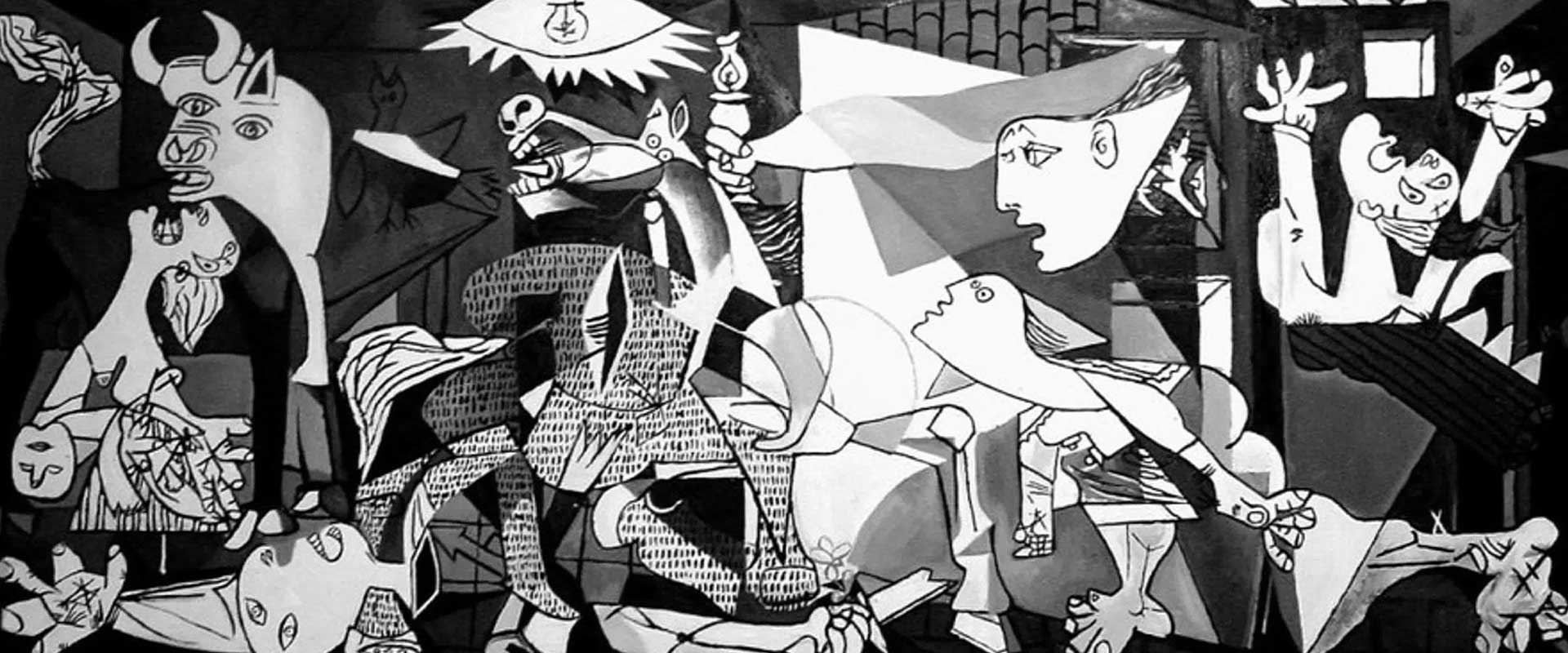When discussing 20th-century art, few works hold the gravity of Pablo Picasso’s Guernica. Painted in 1937 as a response to the bombing of the Basque town of Guernica during the Spanish Civil War, this monumental black-and-white canvas is more than a protest—it is a turning point in modern art.
The Guernica painting is often cited as one of Picasso’s greatest achievements. With its fractured forms, layered symbolism, and political urgency, it redefined how art could bear witness to human tragedy while reshaping the trajectory of modern visual language.
The Historical Context of Guernica
On April 26, 1937, German and Italian planes allied with Francisco Franco launched an air raid on Guernica, leaving devastation and civilian casualties in its wake. The event shocked the world.
Picasso, living in Paris at the time, was commissioned to paint a mural for the Spanish Pavilion at the Paris World’s Fair. Initially uncertain of his subject, he found inspiration in the tragedy, creating Guernica in just weeks.
As explained in Guernica Painting: The Story, Context, and Global Impact, the work transcended its immediate history to become a universal anti-war icon.
Visual Analysis of Guernica
Composition and Palette
The canvas spans 25 feet wide by 11 feet tall, overwhelming in size. The monochrome palette recalls the starkness of newspaper photographs, giving the work urgency and authenticity.
Central Figures and Symbolism
- The Bull: A traditional Spanish symbol, interpreted as brutality or resilience.
- The Horse: Central, wounded, and screaming, symbolizing civilian suffering.
- The Mother with Dead Child: A heart-wrenching echo of religious pietà imagery.
- The Fallen Soldier: His broken body still clutches a shattered sword, from which a small flower emerges—fragile hope amid destruction.
- The Light Bulb: Suspended above, it doubles as an eye, blending technological menace with divine judgment.
- The Woman with the Lamp: Bringing light into chaos, she symbolizes truth and resistance.
As explored in Picasso Guernica Painting: The Symbols You Might Have Missed, hidden elements like a skull in the horse’s mouth deepen its complexity.
Why Guernica Redefined Modern Art
- Demonstrated that modernist abstraction could serve political ends.
- Used Cubist fragmentation to reflect the chaos of war.
- Abandoned color, proving monochrome could carry monumental emotional force.
- Transformed private grief into universal imagery of suffering.
- Turned a painting into a moral statement, not just an aesthetic one.
Guernica and Modern Art Movements
While Picasso had already pioneered Cubism with works like Les Demoiselles d’Avignon (see Picasso Cubism: The Art Movement That Changed Everything), Guernica showed how avant-garde techniques could convey urgent political content.
Its influence extended to Abstract Expressionism, Mexican muralism, and even contemporary street art, where monumental scale and symbolism became tools of protest.
Comparison: Guernica vs Other Picasso Masterpieces
| Painting | Year | Theme | Visual Traits | Legacy |
|---|---|---|---|---|
| The Old Guitarist | 1903 | Poverty, fragility | Blue monochrome, elongated figure | Symbol of empathy |
| Les Demoiselles d’Avignon | 1907 | Modernism, abstraction | Angular Cubist forms | Birth of modern art |
| Guernica | 1937 | War, human tragedy | Monumental, black & white, symbolic chaos | Universal anti-war icon |
| The Weeping Woman | 1937 | Grief | Vivid colors, sharp distortion | Companion to Guernica |
This comparison shows that while Picasso constantly reinvented his style, Guernica stands apart for its monumental political power.
Global Reception and Legacy
At the 1937 Paris World’s Fair
Initially controversial, the painting’s fragmented forms puzzled many viewers. But critics soon recognized its symbolic depth.
Touring the World
Guernica toured internationally, raising awareness of Spain’s suffering and later serving as a broader anti-war protest.
In Spain
Picasso insisted Guernica remain abroad until democracy was restored. It was returned to Spain in 1981, after Franco’s dictatorship ended, and now resides at the Museo Reina Sofía in Madrid.
Why Guernica Still Matters
- Continues to appear in global protests as a banner of peace.
- Remains one of the most visited works in Madrid’s modern art museum.
- Inspires reinterpretations across painting, sculpture, literature, and film.
- Demonstrates art’s ability to confront injustice beyond politics.
For admirers, curated collections like Pablo Picasso Wall Art Prints make the essence of his genius available in personal spaces.
Conclusion
The Pablo Picasso Guernica painting is more than a masterpiece—it is a cultural turning point. Through Cubist forms, symbolic figures, and stark monochrome, Picasso transformed tragedy into a visual cry for humanity.
Its power lies not just in what it depicts but in how it shaped modern art, proving that creativity could serve as a political and moral weapon. Decades after its creation, Guernica continues to challenge, inspire, and remind us of art’s role as a witness to history.
FAQs on Pablo Picasso Guernica
What inspired Picasso to paint Guernica?
The bombing of the Basque town of Guernica during the Spanish Civil War in 1937 inspired Picasso to create the mural.
What does the horse in Guernica symbolize?
It represents innocent civilians suffering during wartime.
Why is Guernica in black and white?
The monochrome palette mimics newspaper photographs, emphasizing urgency and tragedy.
Where is Guernica displayed today?
It is housed at the Museo Reina Sofía in Madrid.
Why is Guernica considered a masterpiece?
Because it combined modernist abstraction with political protest, becoming a universal anti-war symbol that shaped modern art.





